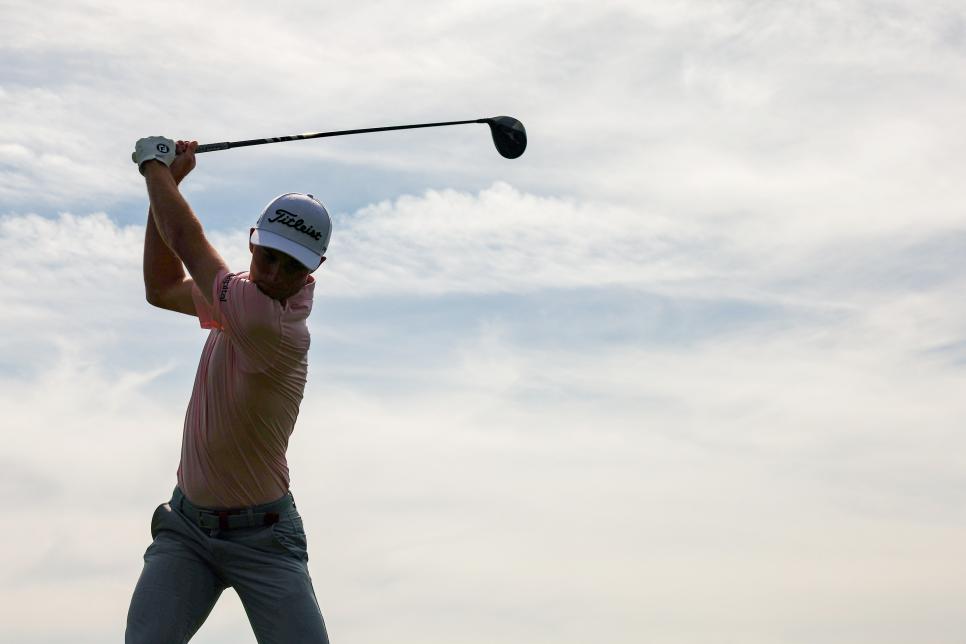Your Questions Answered
Why a shorter-length driver shaft can improve distance and accuracy

Will Zalatoris says switching from a 46-inch driver shaft to a 44.5-inch driver has helped his accuracy without sacrificing distance.
Brennan Asplen
Question: I see some guys on tour using shorter driver shafts than the standard 44.75 to 45 inches. Sounds interesting, but I don't want to lose any distance. Does a shorter driver shaft result in lost distance?
Answer: This is a common misconception. A longer driver shaft can result in extra clubhead speed, but it doesn’t mean the ball is going farther. Center-face contact is a more critical factor for increasing distance, and you’re more likely to find the center of the face using a shorter shaft, which can also lead to greater consistency off the tee. Think about it. The ball doesn’t roll much in the rough but can scoot on the fairway. If you’re finding more fairways with a shorter shaft, your average distance off the tee will likely increase.
“The majority of my driver fittings are at 45 inches or shorter,” says Golf Galaxy’s director of experience and master club fitter Chris Marchini, the author of the company's in-house fitter training manual. “The first thing out of their mouth when you put a shorter shaft in their hands is, ‘Aren't I going to swing this slower?’ What they don’t realize is that a 90-miles-per-hour swing hitting face center with a shorter shaft is going to hit it longer—and straighter—than a 95-mph-swing with a longer shaft.”
Of course, a shorter shaft doesn’t always result in more distance. It could be the benefit of being in the fairway more often with about the same distance. Take Will Zalatoris, who previously played a 46-inch driver but switched to a 44.5-inch driver this year.
“I'm playing a shorter driver,” Zalatoris said of his 9-degree Titleist TSR2 with a Fujikura Ventus Black TR 7X shaft at Bay Hill. “I played a 46-inch in 2022 when I had a great year. Then I went back to the 44.5. I was never really that great with hitting fairways but so far so good with hitting fairways this year. Even though I'm losing a little distance, I'm hitting more fairways, so I'm kind of netting everything out.”
For some, a shorter driver shaft might lead to more confidence and more control. During a past Golf Digest Hot List summit, we conducted a test with a multiple-time winner on the PGA Tour who hit tee shots with drivers measuring 44, 46 and 48 inches. The best results in distance and dispersion came with the 44-inch club.
Another thing to consider with today’s influx of drivers that have ultra-high moments of inertia (aka weighted for extreme stability on off-center impacts): Although a more stable head might make some of the mis-hits caused by a longer shaft less penal, a clubhead like that with a deeper center of gravity and a longer front-to-back measurement might actually reduce your clubhead speed, especially if you find it difficult to square the face. Also, if you reduce the shaft length, make sure the balance point doesn’t change significantly, unless it turns out that the new balance point translates into better contact. If you shorten the shaft, consider adding a little lead tape or a slightly heavier weight screw to balance out the change (in consultation with a fitter). In the end, the driver that gets you the tightest dispersion and most consistent increase in ball speed—not the random home-run ball—ultimately is going to help you the most.
Nick Sherburne, founder of leading clubfitting-franchise Club Champion, believes 90 percent of average golfers use a shaft that is not optimal for their potential. “They just have a run-of-the-mill golf shaft,” he says, admitting, of course, that part of his business is getting golfers to consider a non-stock, one-size-fits-all shaft. “It’s not that what they have is crap; it’s that it’s not specific. The shaft is the missing link to the best possible performance. Get the right shaft, and your swing becomes more effortless. Let the head design solve direction. The right shaft is going to be all about consistency and speed, speed, and more speed."